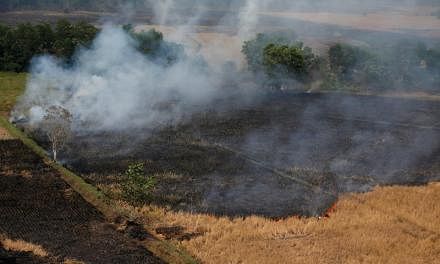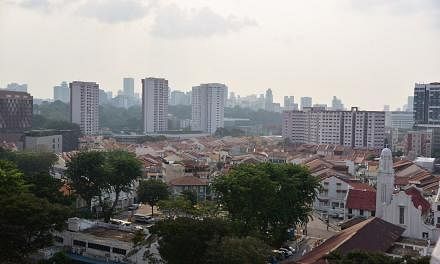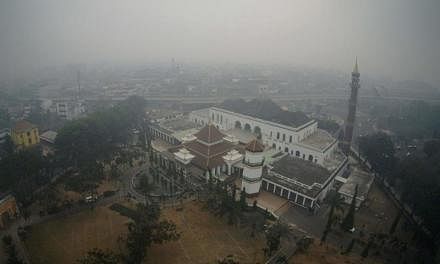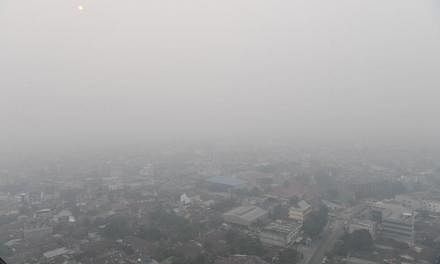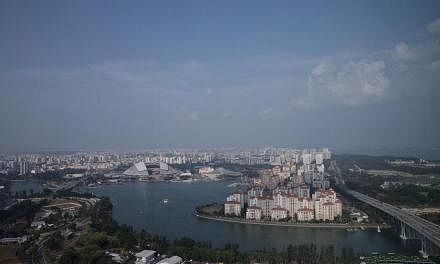SINGAPORE - Fires have been raging in the forests of Indonesia. But, in Singapore, it has been hazy one moment and clear the next.
This is because when it comes to haze, Singapore is at the mercy of the winds.
On Monday (Sept 16), the weatherman cautioned that hazy conditions could persist in the days ahead, with dry weather expected over central and southern Sumatra.
Said the National Environment Agency (NEA): "The prevailing winds are forecast to continue blowing from the south-east or south, and Singapore may still experience slightly hazy conditions."
Air quality in Singapore crept into unhealthy levels for the first time in three years last Saturday. Winds had brought smoke haze from the fires in central and southern Sumatra to Singapore.
But this changed on Sunday, when the wind started blowing from the south-east instead, providing Singapore with some relief from the pollution down south.
The relatively clear skies continued on Monday, with the Pollutant Standards Index (PSI) - a measure of air quality in Singapore - hovering at moderate levels throughout the day. At such levels, normal activity can continue, say the authorities.
On Tuesday at 4pm, the 24-hour PSI was 91-102 in the moderate to unhealthy range. The 1-hour PM2.5 reading was 73-90 micrograms per cubic m, in the elevated band.
The main air pollutant during periods of haze are tiny particulate matter known as PM2.5. The 1-hour PM2.5 concentration readings provide an indication of the current air quality.
Origins of haze
Haze in Singapore usually originates from forest fires burning around the region.
Indonesia, in particular, has been criticised in recent years for not doing enough to prevent and suppress the forest fires on carbon-rich peat soil in the country.
The fires are usually due to farmers using the slash-and-burn tactic.
To make matters worse, the fires tend to occur on peat-soil land granted by the government as concessions. These carbon-rich ecosystems are usually waterlogged.
But cash crops like palm oil and acacia, which are trees grown for the production of pulp and paper, do not do well in waterlogged soil, leading farmers to drain the land, making it more flammable.
In 2015, the annual fire season coincided with an El Nino event - which makes the weather in South-east Asia hotter and drier than usual - and this climate phenomenon caused the forest fires in Indonesia to spiral out of control.
It resulted in the region's worst haze crisis on record.
The World Bank estimated that the fires that year cost Indonesia more than US$16 billion (S$21.9 billion), and studies have shown that the pollution caused 100,000 early deaths in Indonesia, Malaysia and Singapore.
This year, South-east Asia is also experiencing drier-than-usual weather because of persistent cooler-than-usual sea surface temperatures in the eastern Indian Ocean, off the west coast of Sumatra. This discourages the formation of rain clouds over the region.
Associate Professor Koh Tieh Yong, a weather scientist at the Singapore University of Social Sciences, said: "That year was one of the strongest El Nino events on record, whereas the current cooling of the Indian Ocean is moderate by historical standards."
Singapore is currently in the midst of its south-west monsoon season.
The NEA said that during this period, surface winds are expected to blow from the south-east or south and, on occasion, shift to blow from the south-west.
In an update on Monday, the agency said the monsoon rain band is forecast to remain over northern South-east Asia, away from Singapore.
"The prevailing dry weather is expected to continue into the second fortnight of the month," it added.
What brings haze to Singapore
The fires burning in Indonesia do not necessarily mean Singapore will experience haze.
What is key during this period, said Prof Koh, is where the fires are burning and where the wind is blowing from.
Satellite images have shown a surge in the number of hot spots in Indonesia's Sumatra island and in Kalimantan over the past week.
But the recent haze experienced in the Republic came mainly from south Sumatra, which lies directly south of Singapore, Prof Koh told The Straits Times.
Southerly winds brought pollution from the fires there to Singapore last week.
Meanwhile, other fires burning in central Sumatra had caused a dense build-up of particulate matter in the surrounding air.
Turbulence near the surface helped diffuse the pollutants to nearby Singapore, he added.
Thankfully, Singapore got a breather from the pollution when the winds changed direction on Sunday to blow from the south-east instead.
"It is unlikely that the fires in Kalimantan would affect Singapore because it is quite a distance away from us in the south-east direction, unlike Sumatra," said Prof Koh.
Even if south-easterly winds brought haze from Kalimantan to Singapore, the smoke plume would diffuse in all directions on its way over, leaving much lower concentrations of pollutant particles, he added.


